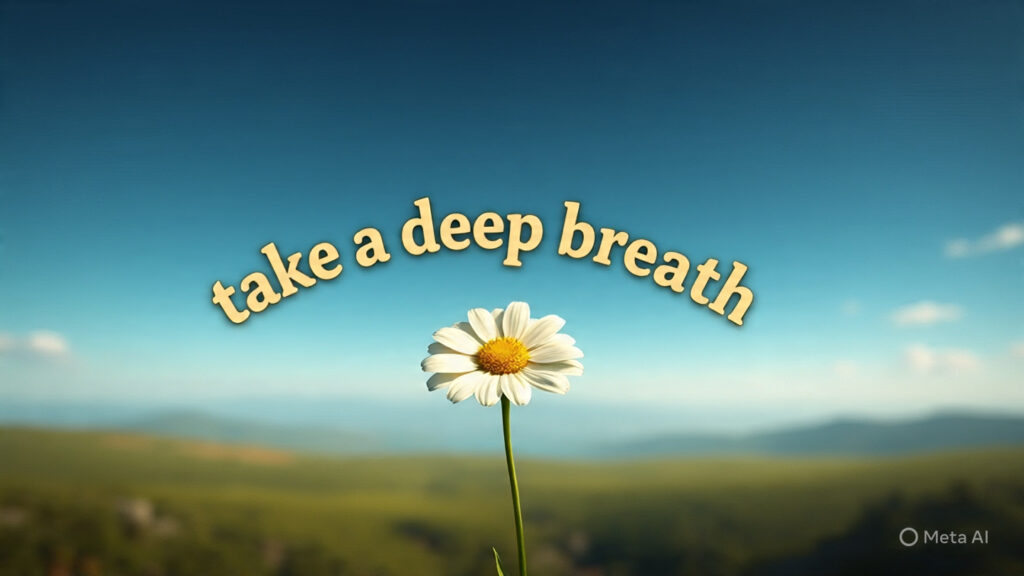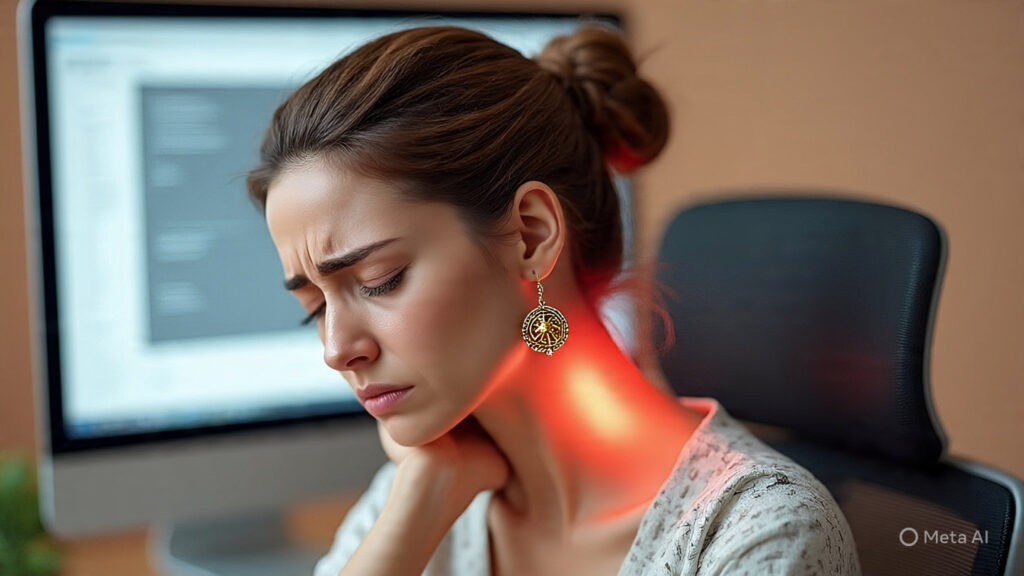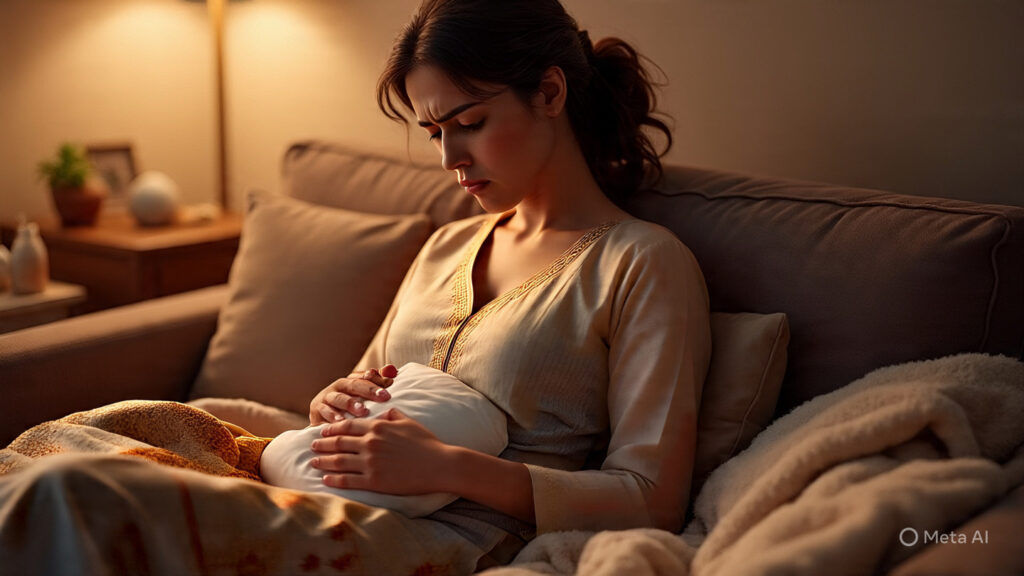URT – Upper respiratory tract Yoga therapy.
Acknowledgement – School of Yoga is deeply grateful to Late Dr. V. Sivaraman for his collaboration of Yoga Therapy for Upper Respiratory Tract (URT) ailments.
Introduction to Respiration.
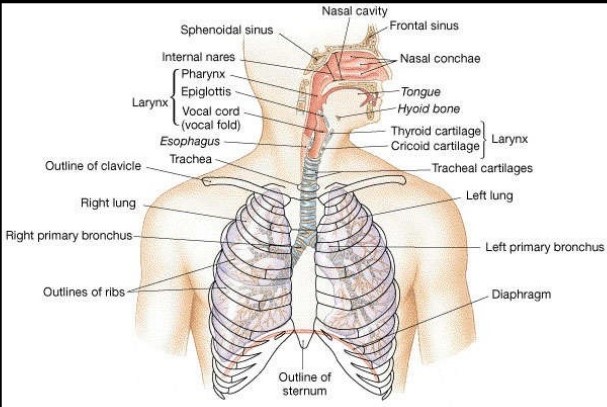
Respiration consists of,
- Ventilation – or breathing is the movement of air from the atmosphere to the lungs (inhalation) and out (exhalation) again.
- External Respiration – is the exchange of gases across the respiratory membrane of the lungs.
- Gases Transport – is the transportation of O2 in the blood to various parts of the body, mainly bound to the protein haemoglobin in red blood cells.
- Internal Respiration – refers to gas exchange across any respiratory membrane during metabolism.
Respiratory anatomy can be split into,
- Upper Respiratory Tract – mouth, nose, nasal cavity, sinuses, epiglottis and larynx
- Lower Respiratory Tract – trachea, bronchi, bronchioles, lungs and alveoli.
The respiration process
Part 1 – Flow of air into the nasal passage
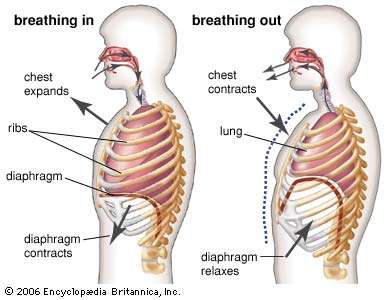
First, air is sucked into the respiratory system through the nostril. How does this occur?
- The diaphragm is a muscle which separates the abdominal cavity from the thoracic cavity. In fact, it is anchored on the lower ribs. So, during inhalation, the diaphragm moves down, creating a negative pressure in the thoracic cavity. Consequently, this draws in air from the atmosphere.
- Next, the movement of the diaphragm is against the movement of the rib cage and abdomen. So, both systems expand to allow the downward movement of the diaphragm. As a result, a reverse pressure is created within the abdomen and rib which forces the diaphragm to move upwards again. Consequently, there is an upward movement of the diaphragm which changes the intra-thoracic pressure from negative to positive, resulting in air being forced out of the lungs.
- Importantly, breathing is a reflex action. Also, it is a parasympathetic process which is controlled by the medulla oblongata. In fact, the rate of breathing is dependent on the concentration of O2 / CO2 and blood ph. Additionally, the pons control the speed of inhalation (speed of the movement of the diaphragm).
Part 2 – Flow of air and awareness
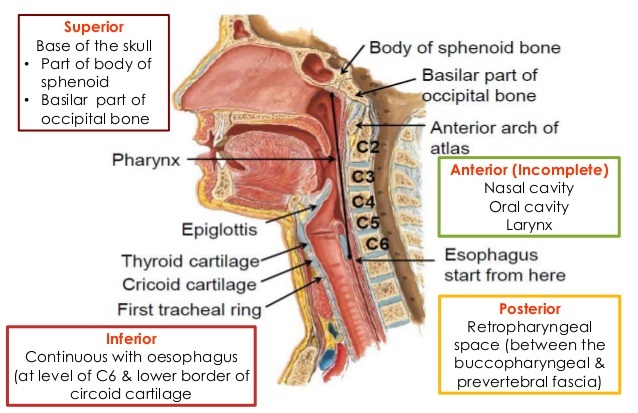
- Initially, when breathing in, air crosses the sinuses. Uniquely, sinuses are pockets of air which secrete mucous into the nasal cavity through orifice called ostia. These open into small recesses called meati and are protected by shelf like projections called turbinates.
- Next, the incoming air is compressed at the bridge of the nose, called septum. This is a venturi like structure which results inthe air getting compressed when entering the nose. Therefore, due to the venturi effect in the septum, the air exits the septum into the nasal cavity under pressure which is lower than atmospheric pressure. Consequently, this causes the air to swirl within the nasal cavity.
- Meanwhile, the fins of the turbinator direct the swirl and split the incoming air.
- One part of the incoming air is guided by the nasal concha over the olfactory epithelium and activates the olfactory bulb.
- Next, the inferior concha guides air over the nasopharynx. This results in a resonating column effect within the auditory tube, which activates the middle ear.
- Importantly, the sinuses are air-pockets, so they resonate to the flow of air and differential pressure between the nasal passage and sinus.
Part 3 – URT dynamics
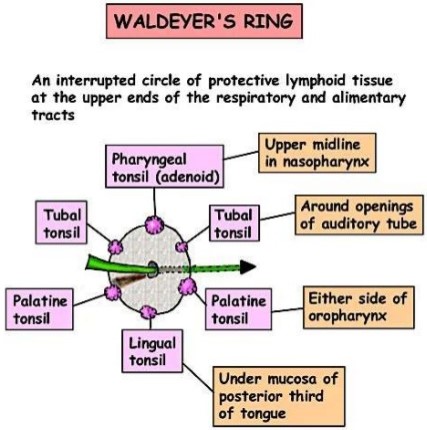
The result of the above movement of air is the creation of a resonance which results in an awareness of being alive. In fact, an most important part of the generation of this awareness are the sphenoid sinus and the auditory tube because they are directly in the passage of draft going into the oropharynx.
There is a slight drop in temperature of the incoming air due to the venture effect, which is compensated by the warm air in the nasal cavity and sinuses. This is why, there is often condensate over the bridge of the nose and, also the reason for the nose being the coldest part of the face.
Part 4 – URT flow of air into the pharynx.
Now, the air now passes over the soft palate into the pharynx. The pharynx consists of 3 parts;
- Nasopharynx corresponds to the passage behind the nose, oropharynx corresponds to the passage behind the mouth and laryngo pharynx corresponds to the passage within the throat area.
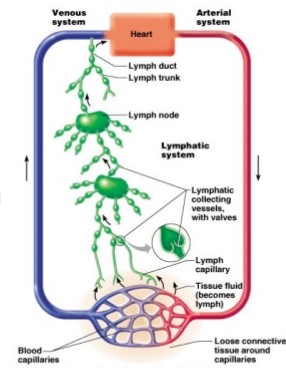
The lymph system - The pharyngeal muscles play a critical role in holding the throat, neck, blood vessel and cervical spine in place. Also, the pharangeal muscles hold the alignment of the nasal and oral passages so that passage of air and food is unrestricted.
- Crucially, the soft palate and epiglottis play an important activity in digestion. During swallowing, the soft palate prevents the upward passage of food into the nasopharynx while the epiglottis covers the trachea. Consequently, the food gets guided into the oesophagus, so the no food enters either the wind pipe or the nasal area.
- There are 4 sets of tonsils in the pharynx – adenoids in the nasopharynx, palatine tonsils in the oropharynx, lingual tonsils in the tongue area, and tubal tonsils in the nasopharynx. In fact, tonsils are lymphoid tissue and also, the body’s first responders to infection.
- Blood supply to the URT area comes from the carotid artery and jugular vein.
- The laryngopharnx splits into 2 tubes – the esophagus to transport food and the larynx to transport air.
- Also, the first part of the larynx comprises the vocal chord and thyroid. Therefore, as the air enters the trachea, it passes over the vocal chords. The thyroid, a critical endocrine organ is placed in front of the trachea.
Part 5 – The lymph system
Lymph system is a passive system which performs which acts as a sentinel to protect the respiratory and digestive tract.
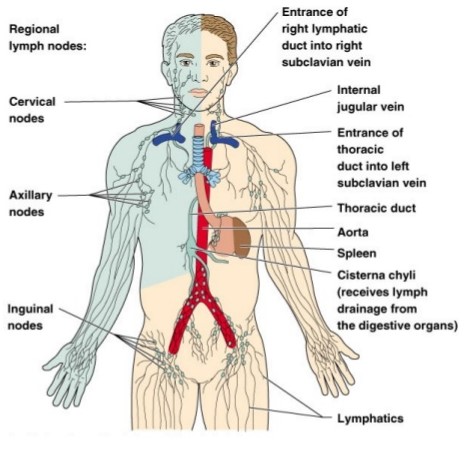
- Firstly, the lymph system performs 4 functions – transport of clean fluid back to the blood, drain excess fluid from tissue, remove debris from cells and transport fat from the digestive system.
- Next, the movement of lymph is by milking action of the muscles and gravity. In fact, this fluid returns to the circulatory veins near the heart through the right lymphatic duct and thoracic duct.
- Lastly, lymph fluid is collected at the lymph nodes.
- These nodes perform 2 functions – housing of microphages which engulf and destroy foreign substances and production of lymphocytes which protect the body from infection.
- Lymphatic function is also supported by spleen, thymus (in thorax), tonsils and peyer’s patches in the walls of the small intestine.
What are the factors that affect URT Health?
The URT is affected by the following parameters;
- Air – atmospheric air enters the body through the nose and mouth. So, poor quality of air can induce infection. Therefore, to prevent this, the first line of defence are the tonsils. In fact, tonsils are lymphoid tissue which try to trap and destroy antigens.
- Food and water – Next, diseases borne by food and water are also handled by the tonsils. However, since food and watertravel into the alimentary canal, there is further protection in the small intestine in the form of peyer’s patches.
- Temperature – Essentially, optimum air and food temperature ensure the maintainance of the health of the URT tissue.
What are the solutions to URT Health using Yoga Therapy?
It is obvious that the Upper Respiratory Tract (URT) is one of the most critical areas of the body. In fact, tt is an intricately designed system of symbiotic structures. However, these parts also have with maximum exposure to infection and abuse. Hence, the health of this system is critical.
The health of the URT may be divided into the following areas;
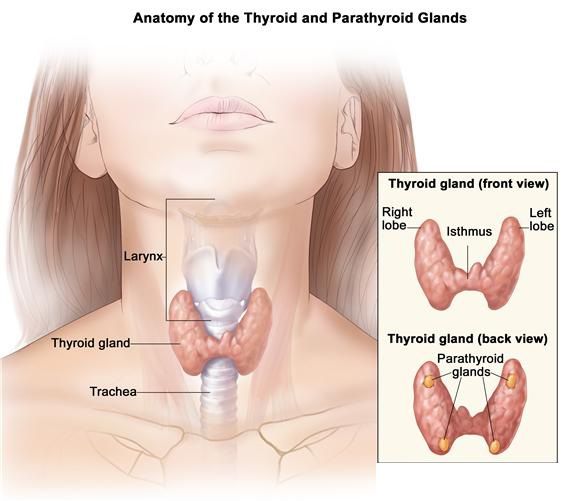
- Increased resistance to air and water infection by strengthening the adenoids and the pharynx. Viparīta-karaṇī, sarvāngāsana, matsyāsana, nāḍī-śuddhi, bhramarī, ujjeyī and bhastrikā prāṇāyāma are critical.
- Increasing strength and flexibility of the pharyngeal muscles. Arda-matsyendrāsana, śirasāsana, viparīta-karaṇī, sarvāngāsana, matsyāsana and ujjeyī prāṇāyāma address this aspect.
- Any activity to increase health of the URT will require improvement in the health of the thyroid. Viparīta-karaṇī, sarvāngāsana, matsyāsana, bhramarī, ujjeyī and bhastrikā prāṇāyāma are critical.
- Breathing is a psychosomatic process which affects the overall health of the body. Hence it is important to ensure breathing is deep, regular and rhythmic to ensure that stress is eliminated from the system. Nāḍī-śuddhi prāṇāyāma and dhyāna are important.
- It is important that the practitioner also keep a clean digestive system as it affects the breathing cycle. Pavanamuktāsana, śalabhāsana and dhanurāsana are critical.
Impact of allergies,
Importantly, to optimise the health of the URT, one should avoid food which causes allergies.
Also,
- Diet – eat small and multiple meals as this affects the movement of the diaphragm and in turn, rhythm of breathing.
- Weight – bring weight down to recommended levels.
- Water – drink plenty of water.
- Sleep – affects stress and catabolic rebuilding of the body and homeostasis.
What can be a Yoga Therapy solution to URT?
- Beginner – 3 months – all āsana to be performed slowly and after OK from doctor.
- Intermediate – 3 months – all āsana to be performed only after improvement is detected and after OK from doctor. Estimated time – 30 mins.
- Final – all āsana to be performed only after substantial improvement is detected and after OK from doctor. Estimated time – 45 mins.
| Āsana (click on the āsana for detailed process) | Beginner | Intermediate | ||
| No | Time frame | 3 months | 3 months | thereafter |
| 1 | Padmāsana | 3 minutes | 3 minutes | 3 minutes |
| 2 | Trikonāsana | 2 | 2 | 2 |
| 3 | Pādahastāsana | 2 | 2 | 2 |
| 4 | Bhujaṃgāsana | 2 | 3 | 3 |
| 5 | Śalabhāsana | 2 | 2 | 3 |
| 6 | Dhanurāsana | 2 | 3 | 3 |
| 7 | Pavanamuktāsana | 2 | 3 | 3 |
| 8 | Arda-halāsana | 2 | 2 | 2 |
| 9 | Sundara-viparītakaraṇi (very important) | 5 minutes | 10 minutes | 15 minutes |
| 10 | Sarvāngāsana (very important) | 3 minutes | 5 minutes | 10 minutes |
| 11 | Matsyāsana (very important) | – | – | 1 x 10 counts |
| 12 | Arda-matsyendrāsana | 1 x 5 counts | 2 x 5 counts | 2 x 5 counts |
| 13 | Śirasāsana (optional) | – | 3 minutes | 5 minutes |
| 14 | Uḍḍīyana-bandhā | 1 x 5 counts | 1 x 5 counts | 1 x 5 counts |
| 15 | Nāḍī-śuddhi prāṇāyāma (important) | 5 x 2 cycles | 5 x 2 cycles | 5 x 2 cycles |
| 16 | Ujjeyī (very important) | 3 x 2 cycles | 5 x 2 cycles | 5 x 2 cycles |
| 17 | Bhastrikā (important) | 10 cycles | 15 cycles | 20 cycles |
| 18 | Śavāsana | 5 minutes | 5 minutes | 5 minutes |
| 19 | Meditation – dhyāna (sit in silence and focus on the breath – very important) | 10 minutes | 10 minutes | 10 minutes |
